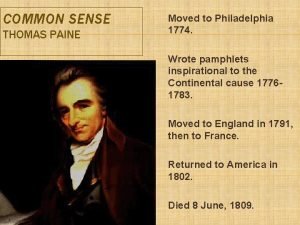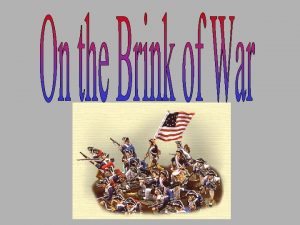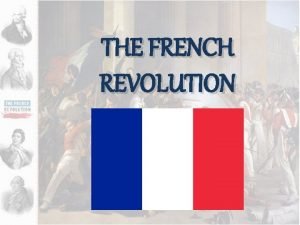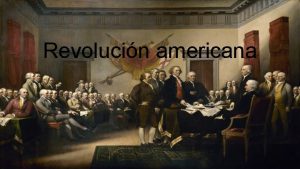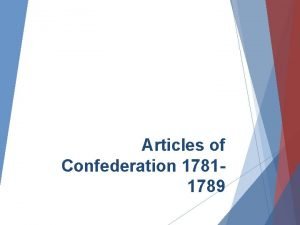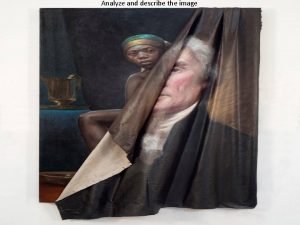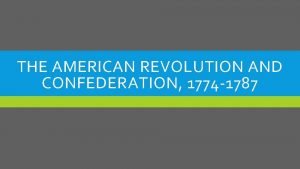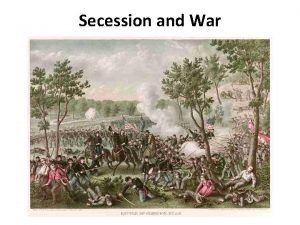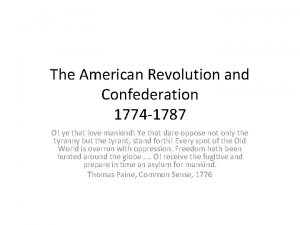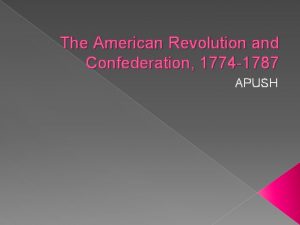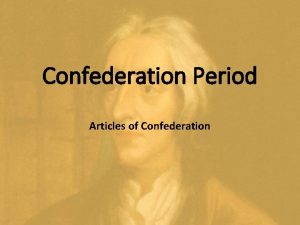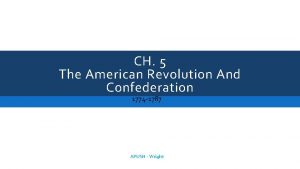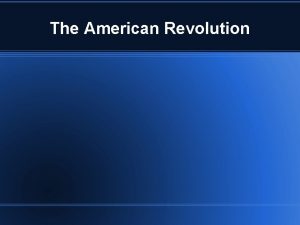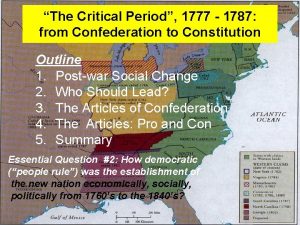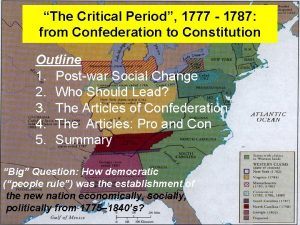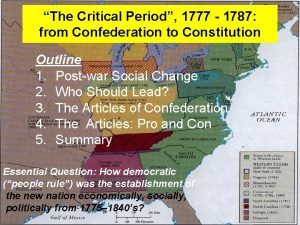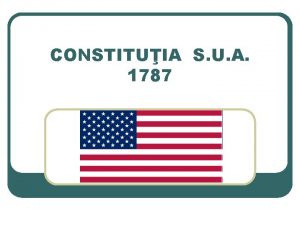The American Revolution and Confederation 1774 1787 Period











- Slides: 11

The American Revolution and Confederation 1774 -1787 Period 3: 1754 -1800 | Amsco Chapter 5 Overview

• 1774: delegates from all states (minus Georgia) sent to Philly • Meant to respond to what they saw as threats to their liberty • Most colonists had no desire for independence • Wanted to restore relationship with the crown • Delegates ranged from conservative to radical (liberal) • Radical: Patrick Henry, Samuel Adams, John Adams • Moderate: George Washington, John Dickinson • Conservative: John Jay, Joseph Galloway • Loyalists were not represented The First Continental Congress

• A vote to form a union in the Empire failed by one vote, instead • • Immediate repeal of Intolerable Acts Declaration of Rights and Grievances to restore colonial rights Called for an increase in boycotting Declared they would meet again in 1775 if demands not met • King George III dismissed the petition • Declared Mass to be in a state of rebellion • Sent troops to restore order Actions of the Congress

• April 18, 1775: British force sent to Concord to seize weapons • Paul Revere’s ride: minutemen assemble in Lexington • First shot? Minutemen retreat • British arrive and destroy supplies; return to Boston • Hundreds of militiamen ambush return journey: 250 British casualties • June 17, 1775: Breed’s Hill outside Boston fortified by militia • A British force was sent to disperse it • Success, but with heavy cost Fighting Begins

• Met in May, 1775: the congress was divided • New England delegates wanted independence • Middle Colonies wanted to negotiate • Military plan initiated • Washington made general and sent to Mass. to assemble forces • Benedict Arnold sent to Canada to draw them away from Britain • The navy and marine corps established • Contradictory statement issued: Olive Branch Petition • King George III dismissed, declaring an open revolt The Second Continental Congress

• Thomas Paine’s argues for independence: 1776 Common Sense • By June, the Congress moved towards independence • Thomas Jefferson’s work, the Declaration of I. , adopted July 4 th • Circa 40% of colonists would support the war; 20 -30% would be loyalists • The mobilization of the colonies • Patriots: fought with local militia • Of several hundred thousand soldiers, Washington could only field 20 k • Africans refused service until British offered them freedom • Congress offered same offer: some 5, 000 would serve • Loyalists: “Tories” from the Parliamentary party • Circa 60 k would fight with the British: 80 k would leave the USA • Native Americans: supported British due to colonial expansion Declaration of Independence

DAY 2 The American Revolution and Confederation 1774 -1787

• The first 3 years went very badly • Washington had poorly trained/equipped soldiers: desertion common • Nearly destroyed: Battle of New York 1776; Philly 1777 • British occupation of American ports: 95% decline in trade • Inflation ruined the American economy • Alliance with France: 1777 following victory at Saratoga • Louis XVI cared little for the revolution but hated Britain • Aid began as early as 1775: money, weapons, supplies • 1778: formal alliance; 1779 Spain and Holland entered war against Britain • Decisive in the revolution, as the war widened and diverted Britain's war effort The Revolutionary War

• Americans campaigned west, occupied Ohio Territory • 1780: British shift focus to south (heavy loyalist) • Heavy French land naval support led to Yorktown 1781 • French and American forces surround Cornwallis: surrender • Treaty of Paris 1783: GB only negotiated with European powers • • 1) GB must recognize USA 2) Mississippi would be western boundary 3) USA got fishing rights in Canada 4) USA would pay debts owed to British merchants Victory 1778 -1779

• 1777: 10 of the colonies had written similar constitutions • Common elements: rights, separation of powers, voting, offices • Articles of Confederation: ratified 1781 • A central government; unicameral legislature: each state 1 vote • 9/13 votes needed; amendments had to be unanimous • Congress could wage war, make treaties, send diplomats, borrow $ • Could NOT regulate commerce or collect taxes • No power to enforce its laws • Successes were limited outside of winning the war • Land Ordinance 1785: surveyed and sold land for settlement • Northwest Ordinance 1787: order for establishing new states Organizing New Governments

• The Articles of Confederation was too weak for three reasons • Financial: debts were unpaid, each state had worthless currency, and no ability to raise money • Foreign: European nations did not respect a bankrupt country; Spain and Britain began to take advantage of the region • Domestic: 1786 Daniel Shays (veteran) led a revolt against high state taxes in Mass. , which was eventually put down • Social change in American society • Separation of Church and State became popular • Women’s rights: women greatly aided the war; remained 2 nd class • Slavery contradicted the revolution “all men are created equal” Issues in the New Country
 8776441774
8776441774 Thomas paine 1774
Thomas paine 1774 The british coercive acts closed boston
The british coercive acts closed boston You should hope this game will be over soon
You should hope this game will be over soon French revolution calender
French revolution calender Convencion de filadelfia 1787
Convencion de filadelfia 1787 Usa 1787
Usa 1787 Northwest ordinance of 1787
Northwest ordinance of 1787 Why was the french government bankrupt in 1787
Why was the french government bankrupt in 1787 Northwest ordinance of 1787
Northwest ordinance of 1787 Northwest ordinance of 1787
Northwest ordinance of 1787 Northwest ordinance of 1787
Northwest ordinance of 1787

